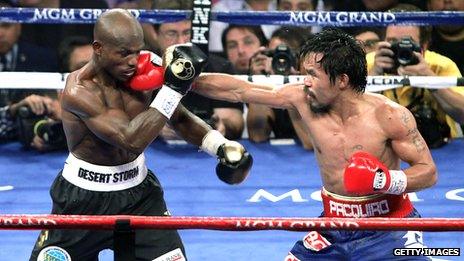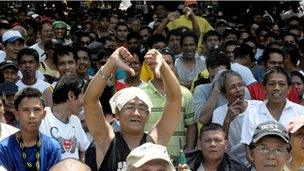Pacquiao v Bradley: Counting punches
- Published

Pacquiao (right) was widely thought to have won the fight
Earlier this month, Manny Pacquiao, a man many feel is the world's best boxer, lost in a split decision to unbeaten American Timothy Bradley. But now a World Boxing Organisation review says Pacquiao should have been declared the winner. Why has this fight been so controversial? The answer lies in the statistics.
As soon as the fighting ended at the MGM Grand on 9 June, the general consensus of those watching was that the Filipino boxing champion Manny Pacquiao had won.
Before the judges had been able to give their scores, Timothy Bradley is reported to have told his promoter: "I tried hard but I couldn't beat the guy."
But when the scores were announced, it turned out that two of the three judges thought Bradley had beaten Pacquiao, and their opinion carried the result, which meant Pacquiao lost his WBO welterweight title to Bradley.
"Everybody was just pretty much in shock. There was a lot of booing from the crowd, it was obviously a pro-Pacquiao crowd. But mostly, I think everybody was pretty stunned," says Bob Canobbio, who was sitting crunching numbers from the ringside of the fight.
His business CompuBox analyses boxing statistics.
Looking at this fight, Canobbio found that Pacquiao landed more punches in 10 of the 12 rounds.
Overall, Pacquiao landed 253 punches to Bradley's total of 159.
But Canobbio and his team also analysed the type of punches thrown.
"A fighter could land less punches in a fight, but if he is landing the harder punches you could justify him winning rounds and winning the fight."

Manila fell silent when Pacquiao was declared the loser
So the Compubox system also counts power punches. These are the punches that can do the damage in a fight including hooks, uppercuts and straight rights not the jabs.
When they broke down the numbers, they found that Pacquiao was still on top.
Although Timothy Bradley threw more punches, less than 20% of them actually connected. Pacquiao was more accurate, especially with his power punches. He landed 190 power punches to Bradley's 108.
"Some say that Bradley was busier- he threw more punches but that number was bolstered by his jab.
"He threw 449 jabs, and a lot of those jabs were what we call a pawing jab, a range finder jab, really not thrown with the intention of landing, but more to set up the next punch.
"So yes, Bradley was busier, but Pacquiao threw the more effective punches," says Canobbio.
If these statistics show that Pacquiao not only landed the most punches, but also landed the most powerful ones, then why did two of the three judges score him lower than Bradley?
Canobbio has a theory for what might have happened in this fight.
He looked at each round and discovered that Pacquiao was landing more of his punches in the last minute of the three minute rounds.
"This is an old trick which Mohammed Ali and Ray Leonard used to use, where they would rally in the last minute of the round to try and sway the judges," says Canobbio.
And that is exactly what Pacquiao seems to have done as 48% of his 253 connects took place in the last minute.
"You would think that this would have solidified his standing - it would still have been fresh in the judges' minds.
"But if you look at the other side of the coin, maybe the judges were looking at the first two minutes- 'Oh Manny is having another slow round, he's not landing as many punches in the first two minutes.'
"So maybe that swayed the judges."
Following the uproar after the fight, the World Boxing Organisation (WBO) instigated a review.
Five international judges evaluated a video of the fight and they unanimously scored it in favour of Pacquiao.
But the original result stands as the WBO does not have the power to overturn it.
Bradley is still the winner but the numbers tell a different story.